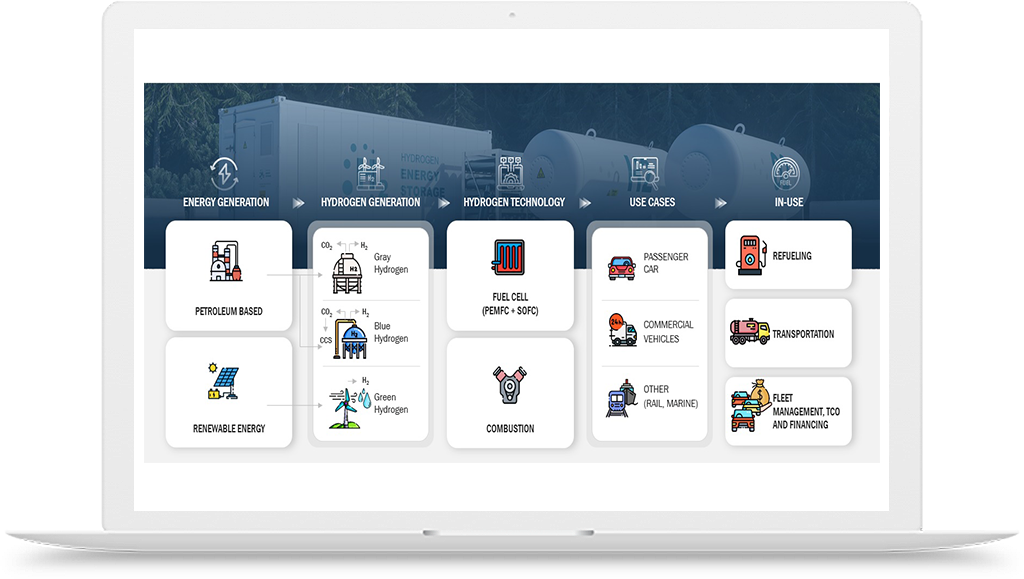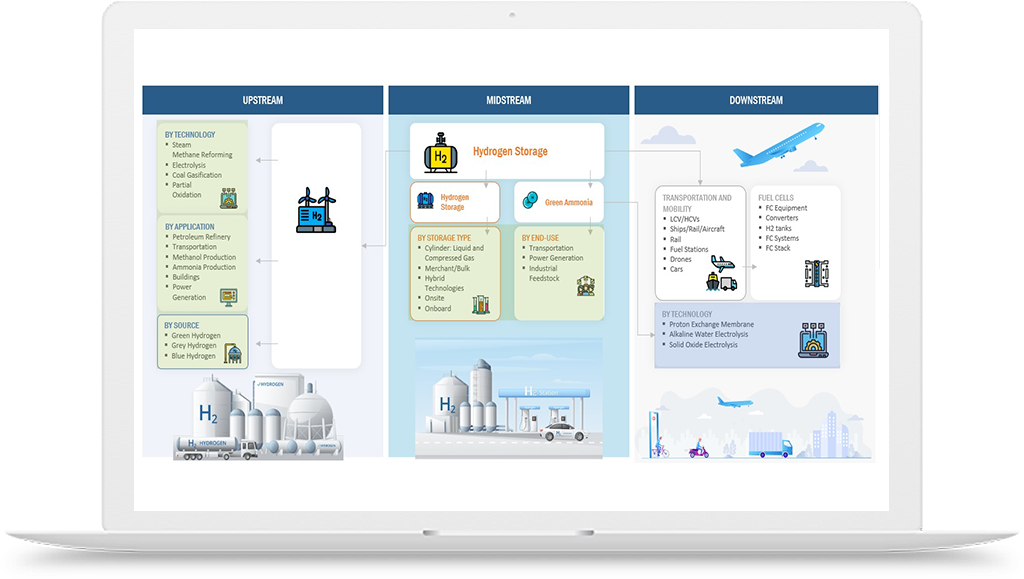Hydrogen Growth Opportunities
The hydrogen sector is poised for hydrogen growth opportunities in areas such as environmentally friendly hydrogen production, the use of hydrogen fuel cells and the development of a comprehensive hydrogen infrastructure.
In order to support a sustainable energy transition, hydrogen Growth Opportunities entails making strategic investments in research and development, encouraging innovation in electrolysis technologies, storage solutions, and the integration of hydrogen into various sectors.
Hydrogen growth opportunities are gaining prominence as governments and industries around the world pledge to reduce carbon emissions. These opportunities present means of fostering economic expansion, employment generation, and the construction of a strong and resilient hydrogen economy.
Growth Opportunities in Refining Industry
The opportunities for the development of hydrogen in the refining sector are significant. As the world moves toward a low-carbon economy, the need for cleaner fuels and more efficient refining processes is increasing. Hydrogen allows the refining industry to meet these demands while improving overall environmental performance.
One of the biggest opportunities for the development of hydrogen in the refining sector is the growing demand for cleaner fuels. Governments around the world are introducing stricter emissions standards for transportation fuels, increasing demand for cleaner fuels like hydrogen. The use of hydrogen in refining processes reduces the sulfur and carbon content of fuels, improving their environmental efficiency and reducing greenhouse gas emissions.
Another opportunity for the development of hydrogen in the refining sector is the growing focus on energy efficiency. Hydrogen can help refineries achieve greater energy efficiency in their processes, which can help reduce costs and increase profitability. By using hydrogen in refining processes such as hydrocracking and catalytic reforming, refineries can reduce energy requirements and increase yields of high-quality products.
In addition to cleaner fuels and energy efficiency, hydrogen also offers development opportunities in the field of renewable energies. Renewable hydrogen can be produced using renewable energy sources such as solar and wind, which can help reduce emissions and support the transition to a low-carbon economy. Refineries can use renewable hydrogen to power their refining processes, reducing their reliance on fossil fuels and further reducing their environmental impact.
Finally, the growing demand for hydrogen as a transportation fuel creates a significant development opportunity for the refining industry. Hydrogen fuel cell vehicles are becoming increasingly popular, and refineries can play a key role in the production and distribution of hydrogen. By producing and distributing hydrogen fuel, refineries can diversify their product offerings and conquer new markets.
Growth Opportunities in Chemical Industry
The use of hydrogen in the chemicals industry offers several growth opportunities, including:
- Increasing demand for chemicals: Population expansion, urbanization, and industrialization are projected to drive up demand for chemicals in the upcoming years. The need for hydrogen as a feedstock and energy source is anticipated to rise along with the demand for chemicals.
- Sustainability and environmental concerns: The chemical industry is under increasing pressure to reduce its impact on the environment and adopt more sustainable production methods. The use of hydrogen in chemical processes has significant environmental benefits, including reducing emissions and improving energy efficiency.
- Renewable energy integration: The use of renewable energy sources to produce hydrogen offers significant growth openings in the chemical’s assiduity. The integration of renewable energy with hydrogen products can help to reduce emigration and ameliorate the sustainability of chemical products.
- Innovation and technology advancements: The development of new technologies and innovative processes stimulates the development of the chemical industry. The use of hydrogen in chemical processes creates opportunities for innovation and technological advancement, including the development of new catalysts and new process designs.
- Global market expansion: The global chemicals assiduity is expanding fleetly, with adding demand from arising requests in Asia, Africa, and Latin America. The growth of the chemicals assiduity in these regions is anticipated to drive the demand for hydrogen as a feedstock and energy source.
Growth Opportunities in Steel Production Industry
The growth opportunities involved in the application of hydrogen in steel production are significant. Here are some of the key growth opportunities:
- Expansion of existing hydrogen-based steel production:Some steel directors have formerly started using hydrogen in their sword product processes, and the trend is anticipated to continue. The expansion of hydrogen- grounded sword product installations is one growth occasion for the assiduity.
- Development of new hydrogen-based steel production facilities: This represents yet another avenue for industry expansion. The development of new hydrogen-based steel production technologies is being investigated by a number of technology companies and steel producers, which may lead to a greater industry adoption of hydrogen.
- Development of hydrogen production and delivery infrastructure: Expanding the infrastructure for the production and supply of hydrogen is crucial for the development of the hydrogen-based steel industry. Creating infrastructure for the production and supply of hydrogen would increase the availability and affordability of hydrogen for use in steel production.
- Adoption of hydrogen-based technologies in emerging markets: Increasing In the upcoming years, it is anticipated that the demand for steel will rise significantly in emerging markets like Asia and Africa. The industry that produces hydrogen-based steel may expand as a result of these markets adopting hydrogen-based technologies.
- Collaboration between industry stakeholders: including steelmakers, technology companies and government agencies, could accelerate the adoption of hydrogen-based steelmaking technologies. Collaboration can help solve technical, economic and regulatory challenges and lead to faster adoption and development in the industry.
Growth opportunities in glass manufacturing industry:
- Adoption of hydrogen-based technologies by glass manufacturers: Energy efficiency and emission reduction could be achieved by glass manufacturers implementing hydrogen-based technologies. This might result in more rivalry and even new sources of income.
- Development of hydrogen production and delivery infrastructure: The expansion of the hydrogen-based glass manufacturing sector depends on the development of infrastructure for hydrogen production and delivery. The construction of infrastructure for the production and delivery of hydrogen would improve the gas's accessibility and availability for use in the glass industry.
- Collaboration between industry stakeholders: The adoption of hydrogen-based glass manufacturing technologies could be accelerated by cooperation between industry stakeholders, such as glass manufacturers, technology companies, and governmental organizations. Working together may make it easier to overcome technical, financial, and legal obstacles, which would hasten the industry's adoption and expansion.
Growth opportunities in Semiconductor Industry:
- Adoption of hydrogen-based technologies by semiconductor manufacturers: It may be possible to lower costs and enhance product quality if semiconductor manufacturers adopt hydrogen-based technologies. This might result in more rivalry and even new sources of income.
- Development of hydrogen production and delivery infrastructure: The expansion of the hydrogen-based semiconductor industry depends on the development of infrastructure for hydrogen production and delivery. The construction of infrastructure for hydrogen production and delivery would improve the gas's accessibility and availability for use in the production of semiconductors.
- Collaboration between industry stakeholders: The adoption of hydrogen-based semiconductor manufacturing technologies could be accelerated by cooperation between industry stakeholders, such as government agencies, technology companies, and semiconductor manufacturers. Working together may make it easier to overcome technical, financial, and legal obstacles, which would hasten the industry's adoption and expansion.
Growth Opportunities in Mobility Industry:
- Heavy-duty trucks and buses: Heavy-duty trucks and buses powered by hydrogen fuel cells have a lot of potential, according to a study by the Hydrogen Council. This is especially true for long-haul applications, where the high energy density of hydrogen can provide a long driving range without the weight and space constraints of large battery packs. According to the study, there could be a $116 billion potential yearly revenue potential for the market for hydrogen-powered heavy-duty trucks and buses by 2030, when it reaches 2 million vehicles.
- Passenger cars: Although there are currently only a few models of hydrogen fuel cell passenger cars available, there is hope that the technology will continue to advance and grow in the years to come. The market for hydrogen fuel cell passenger cars is anticipated to expand from approximately 4,000 units annually in 2020 to over 2 million units annually by 2050, per a report published by Bloomberg NEF. According to the report, there could be a $700 billion market for hydrogen fuel cell vehicles by 2050.
- Trains and ships: Additionally, trains and ships can run on hydrogen as a fuel, especially in situations where electrification is impractical owing to poor infrastructure or long distances. The market for hydrogen-powered trains and ships could reach $200 billion by 2050, according to a McKinsey & Company report. This could result in an annual reduction of up to 400 million tons of carbon dioxide emissions.
- Material handling equipment: Forklifts and other material handling equipment are already powered by hydrogen fuel cells in warehouses and distribution centers, which offer a more effective and environmentally friendly option than conventional lead-acid batteries. The Fuel Cell and Hydrogen Energy Association reported that by 2024, the global market for material handling equipment powered by hydrogen might grow to $4.5 billion.
- Aviation: Although the technology for hydrogen-powered aircraft is still in its infancy, it might find application in smaller regional aircraft for which electrification is not an option. By 2050, there may be a $15 billion market for hydrogen-powered aircraft, according to a report from the International Energy Agency.
Growth opportunities of Aerospace Defence in hydrogen space
The aerospace and defense industries have significant growth opportunities in the hydrogen space, particularly in the areas of propulsion systems, fuel cells, and power generation. Here are some of the growth opportunities for hydrogen in the aerospace and defense industries:
- Zero-emissions flight: Electric aircraft powered by hydrogen fuel cells can fly without emitting any emissions. This technology has the power to transform air travel and lessen the carbon footprint of the aviation sector. A number of prototypes of hydrogen fuel cell-powered aircraft are currently under development, thanks to investments made by aerospace companies.
- Military applications: Hydrogen finds numerous uses in the defense sector, such as fuel cells for submarines and other underwater vehicles and portable power generation. The United States military is currently investing in hydrogen fuel cell technology for unmanned aerial vehicles (UAVs) and is investigating the possibility of using fuel cells for other purposes, like military base backup power systems.
- Space exploration: In the space industry, hydrogen has long been used as a propellant, and interest in employing hydrogen fuel cells to generate electricity in orbit is growing. Fuel cells are lightweight and dependable, which makes them perfect for powering spacecraft and other vehicles. This makes them well-suited for use in space applications.
- Infrastructure development: Infrastructure to support the operation of hydrogen-powered vehicles and aircraft will be required as demand for these products rises. Infrastructure development, including the construction of hydrogen refueling stations, can be greatly aided by aerospace and defense companies.
- Collaboration with other industries: The automotive industry, for example, can work with the aerospace and defense sectors to develop hydrogen technology. The sharing of best practices and the creation of new technologies may result from this collaboration.
In conclusion, there are a lot of growth prospects in the hydrogen space for the aerospace and defense industries, especially in the areas of zero-emission flying, military applications, space exploration, building infrastructure, and partnering with other industries. The aerospace and defense sectors are ideally positioned to take the lead in the advancement and commercialization of hydrogen technology, given the increasing demand for clean energy.
Growth opportunities of Gardening in Hydrogen Space
Hydrogen can have various applications in the gardening industry, particularly in the use of fuel cells in lawnmowers, leaf blowers, and other garden equipment. The growth opportunities in this industry include:
- Reduction in emissions: The greenhouse gas emissions from the gardening industry are substantial. The carbon footprint of gardening activities can be decreased by using equipment that runs on hydrogen.
- Increasing demand for sustainable products: Consumers are increasingly aware of the impact of their actions on the environment. The demand for sustainable products is growing and hydrogen-powered garden tools can represent an environmentally friendly alternative.
- Innovation in product design: Hydrogen gardening tools are relatively new and require innovation in product design to create efficient and reliable tools. This gives manufacturers the opportunity to stand out from the competition by offering high quality products that meet customer needs.
- Government incentives: Businesses that invest in sustainable technologies can receive incentives and subsidies from numerous governments across the globe. This may give businesses hoping to create and sell gardening tools powered by hydrogen an extra push.
- Expansion of the hydrogen economy: As hydrogen becomes more widespread, the infrastructure to support this technology will also expand. This makes it easier for horticultural companies to access the resources they need to develop and market their products.
Growth opportunities of Lab-grown Diamond Manufacturing in hydrogen space
The demand for ethical and sustainable alternatives to natural diamonds has increased, and this has led to a notable boom in the lab-grown diamond manufacturing sector in recent years. Hydrogen plays a pivotal role in multiple phases of the laboratory-grown diamond production procedure, rendering it a vital constituent in the industry's ascent and proliferation.
One of the main uses of hydrogen in the production of synthetic diamonds is the high-pressure-high-temperature (HPHT) process, which is the most commonly used process for producing synthetic diamonds. In this process, a small diamond grain is placed in a press and subjected to extreme pressure and temperature. Hydrogen is used as an energy source to heat the press and maintain the required temperature and pressure levels. This process allows for the production of larger, higher quality diamonds, which are increasingly in demand in jewelry and industrial applications.
Another use of hydrogen in the production of laboratory diamonds is chemical vapor deposition (CVD), a newer and less common method of producing diamonds. In this process, a diamond grain is placed in a chamber containing a carbon-rich gas and hydrogen is used to facilitate the chemical reaction that creates a diamond. This process allows for more precise control over the size, shape and quality of the diamonds produced, making it ideal for industrial and electronic applications.
There are great growth prospects for hydrogen in this market as the demand for lab-grown diamonds keeps rising. Hydrogen is anticipated to be essential to ongoing research and development efforts to increase the productivity and sustainability of the lab-grown diamond manufacturing process. Furthermore, the demand for lab-grown diamonds is anticipated to rise as more consumers become aware of the ethical and environmental issues surrounding natural diamond mining. This will propel industry growth and further highlight the necessity of hydrogen as a critical component in the manufacturing process.
Growth opportunities of Construction Equipment in Hydrogen Space
The construction machinery industry is also researching the use of hydrogen as an alternative fuel source. Hydrogen fuel cells can power a variety of construction equipment, including excavators, loaders, bulldozers and excavators, to reduce emissions and improve energy efficiency.
One of the opportunities for the development of hydrogen in the construction machinery sector is the growing demand for environmentally friendly and low-emission machines. As governments around the world introduce stricter regulations on emissions from construction equipment, companies in the industry are looking to alternative fuels to remain.
Another opportunity lies in the possibility of long-term savings. While the initial capital cost of hydrogen-powered equipment may be higher than that of traditional diesel-powered equipment, fuel and maintenance costs over the life of the machine may be lower for hydrogen-powered equipment. This can give companies in the industry a competitive advantage.
Moreover, the versatility of hydrogen fuel cells could offer further growth opportunities. Hydrogen-powered construction equipment can be used in remote areas without access to electricity grids, making them an attractive option for expanding infrastructure in remote or off-grid locations.
There is also potential for partnerships between construction equipment companies and hydrogen infrastructure providers, such as hydrogen filling stations. As hydrogen infrastructure continues to develop, the use of hydrogen-powered devices will become increasingly accessible and feasible for businesses.
Frequently Asked Questions (FAQ):
What are the opportunities for hydrogen?
Hydrogen presents opportunities for a wide range of applications, including clean energy generation, decarbonization of industries such as transportation and manufacturing, energy storage, and as a versatile chemical feedstock. It can contribute to a more sustainable and low-carbon future by leveraging renewable energy sources for hydrogen production and enabling the transition to a hydrogen economy.
What is the growing demand of hydrogen?
The demand for hydrogen is growing due to increasing efforts to decarbonize various sectors, such as transportation, industry, and power generation. Hydrogen is seen as a key solution for achieving carbon neutrality and meeting climate goals, driving the demand for clean and sustainable energy alternatives.
Is the hydrogen market growing?
Yes, the hydrogen market is experiencing significant growth as countries and industries worldwide recognize its potential as a clean energy carrier. Investments, government initiatives, and technological advancements are driving the expansion of the hydrogen market, creating new opportunities for production, storage, distribution, and utilization of hydrogen across various sectors.
What are the future prospects for hydrogen?
The future prospects for hydrogen are promising, with a growing focus on its role in decarbonization, renewable energy integration, and the transition to a low-carbon economy. Advancements in hydrogen production, storage, and utilization technologies, along with supportive policies and investments, are expected to drive its widespread adoption and establish hydrogen as a key pillar of the clean energy future.
















